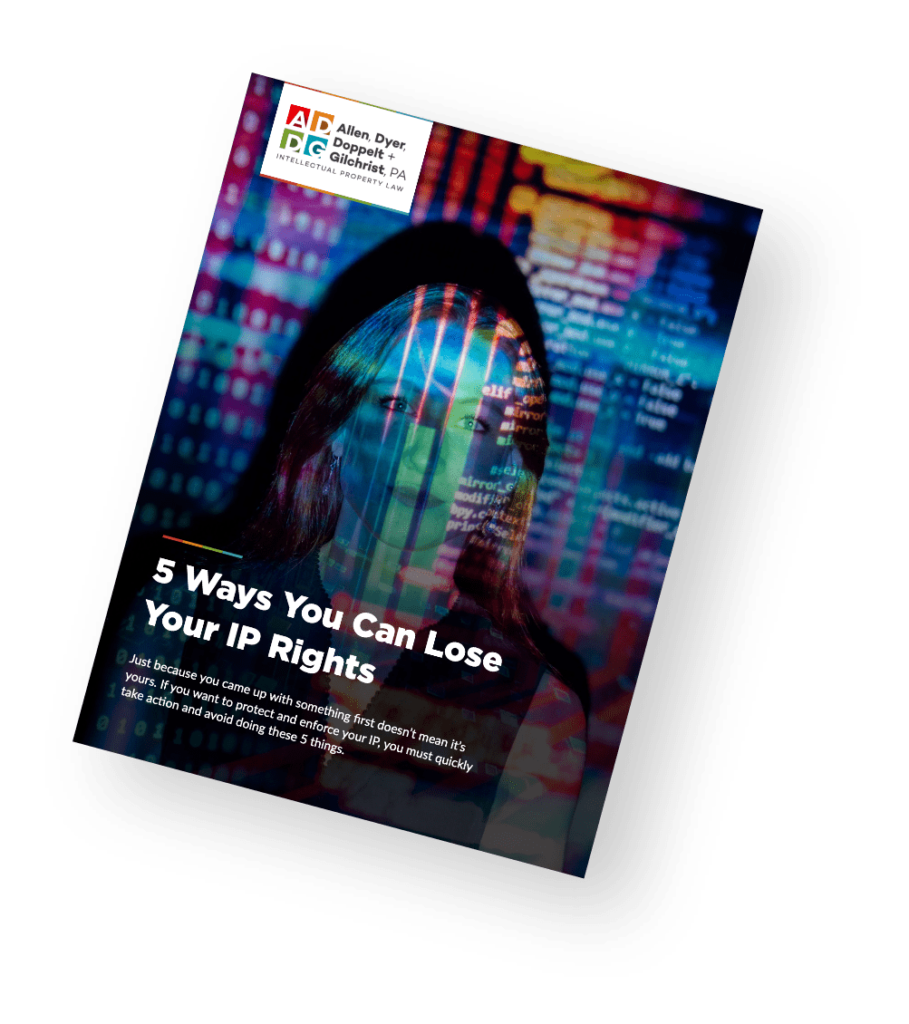Intellectual property (IP) is incredibly valuable in today’s knowledge-based economy, and can often be a company’s most important asset. IP is commonly used as a defensive asset to give a competitive advantage in the marketplace, but in some circumstances, it may be leveraged as a source of revenue. This is done through IP licensing. In this article, we discuss the specifics of IP licensing, the different forms of licensing available to IP owners, and how to license your intellectual property effectively.
What is IP Licensing & How Does it Work?
Intellectual property licensing involves a legal agreement between two parties: the IP rights owner (licensor) and another party (licensee) who is authorized to use those rights for contractually agreed purposes. This agreement is typically in exchange for monetary value, often in the form of an upfront fee, royalties, or both.
IP owners may agree to license copyrighted material, trademarks & patents, or specific knowledge such as trade secrets or proprietary technical information. Some licensing agreements may include a bundle of IP rights including patents, copyrights, trade secrets or “know-how”, and/or trademarks.
Forms of IP Licensing
Intellectual property licensing can take a variety of forms. Here are a few of the most common ways that owners can license their IP:
- Technology licensing: This involves using technical information, processes, methods, or a combination of these. It’s often used in industries such as software, manufacturing, and biotechnology.
- Trademark and franchising licensing: Here, the licensee uses the licensor’s brand name or trademark. This is common in the retail and food service industries, where a franchisee operates under the franchisor’s brand.
- Copyright licensing: This covers literature or artistic work, such as books, music, and films. The licensee is granted rights to reproduce, distribute, or display the copyrighted work.
- Patent licensing: This involves the use of inventions protected by patents. The licensee can manufacture, use, or sell the patented invention, often in return for royalty payments.
A single licensing contract may involve the transfer of multiple types of IP rights, or single-purpose uses. The rights granted to the licensee may or may not be exclusive, meaning only the licensee is permitted to use the IP. Non-exclusive licensing means the licensor can license the IP to multiple licensees. Under sole licensing, both the licensor and licensee can use the IP. These rights may also be limited by a geographic area, a particular market, or a specific license period.
Reasons For Licensing Your IP
Licensing your IP can provide a host of benefits. It can create additional revenue streams, increase market share, and provide easier access to new markets or geographical territories. Licensing can also allow for shared risk, access to local expertise, and the opportunity to minimize capital investment when entering a new market.
Additionally, licensing can broaden your competitive advantage and increase collaboration opportunities. For instance, a company may have intellectual property it considers not to be part of its core business and might consider licensing it out to another party who sees an opportunity and is interested in exploiting the IP.
How To License Your IP
Licensing your intellectual property is a strategic process that requires careful planning and execution. Here are the main steps involved:
- Identify your IP: Clearly identify what you own. This could be patents, trademarks, copyrights, or trade secrets.
- Valuation: Before you enter into a licensing agreement, have your IP rights valued to ensure the terms of the license reflect a fair sharing of risk and rewards.
- Find potential licensees: Research and identify companies or individuals who might be interested in licensing your IP. This could be businesses in the same industry or in different industries that could benefit from your IP.
- Negotiate terms: The parties agree on the terms and conditions via negotiation, with the outcome dependent upon the commercial opportunity that the IP unlocks.
- Draft the agreement: Key components of a license include the rights granted, terms of the license, financial consideration, and who is responsible for pursuing infringers.
- Execute the agreement: After the agreement is drafted and both parties are satisfied with the terms, both parties sign the agreement, and the licensee pays the agreed-upon fee or royalty.
- Manage the agreement: Ensure that both licensor and licensee are adhering to the terms of the agreement, which can involve regular check-ins and audits.
Other important factors include whether or not to grant exclusive licenses, the market in which the IP will be used, the territory covered by the license, enforcement of intellectual property rights, ongoing payment of IP maintenance and protection fees, and the time period of the license.
What Are The Components of a License?
A typical IP licensing agreement includes several key components. The first is the grant clause, which outlines what the licensee can and cannot do with the IP. Other terms of the license include the duration and scope, as well as financial considerations, such as the amount and schedule of royalty payments.
The agreement should also specify reporting and record-keeping requirements, warranties and representations made by both parties, the process for handling potential IP infringement, and liability disclosures.
Schedule a Consultation with an Experienced IP Attorney
If you’re considering licensing your IP, an experienced intellectual property attorney can guide you through the process, help you understand the potential benefits and risks, and protect your interests. They can provide advice on licensing terms, how to ensure the agreement meets required business objectives and opportunities afforded by the licensed IP rights.
Contact us to book a consultation today!
How To License Your Intellectual Property
Intellectual property (IP) is incredibly valuable in today’s knowledge-based economy, and can often be a company’s most important asset. IP is commonly used a defensive asset to give a competitive advantage in the marketplace, but in some circumstances it may be leveraged for as a source of revenue. This is done through IP licensing. In this article, we discuss the specifics of IP licensing, different forms of licensing available to IP owners, and how to license your intellectual property effectively.
What is IP Licensing & How Does it Work?
Intellectual property licensing involves a legal agreement between two parties: the IP rights owner (licensor) and another party (licensee) who is authorized to use those rights for contractually agreed purposes. This agreement is typically in exchange for monetary value, often in the form of an up front fee, royalties, or both.
IP owners may agree to license copyrighted material, trademarks & patents, or specific knowledge such as trade secrets or proprietary technical information.Some licensing agreements may include a bundle of IP rights including patents, copyrights, trade secrets or “know how”, and/or trademarks.
Forms of IP Licensing
Intellectual property licensing can take a variety of forms. Here are a few of the most common ways that owners can license their IP:
- Technology licensing: This involves the use of technical information, processes, methods, or a combination of these. It’s often used in industries such as software, manufacturing, and biotechnology.
- Trademark and franchising licensing: Here, the licensee uses the licensor’s brand name or trademark. This is common in the retail and food service industries, where a franchisee operates under the franchisor’s brand.
- Copyright licensing: This covers literature or artistic work, such as books, music, and films. The licensee is granted rights to reproduce, distribute, or display the copyrighted work.
- Patent licensing: This involves the use of inventions protected by patents. The licensee can manufacture, use, or sell the patented invention, often in return for royalty payments.
A single licensing contract may involve the transfer of multiple types of IP rights, or single-purpose uses. The rights granted to the licensee may or may not be exclusive, meaning only the licensee is permitted to use the IP. Non-exclusive licensing means the licensor can license the IP to multiple licensees. Under sole licensing, both the licensor and licensee can use the IP. These rights may also be limited by a geographic area, a particular market, or a specific license period.
Reasons For Licensing Your IP
Licensing your IP can provide a host of benefits. It can create additional revenue streams, increase market share, and provide easier access to new markets or geographical territories. Licensing can also allow for shared risk, access to local expertise, and the opportunity to minimize capital investment when entering a new market.
Additionally, licensing can broaden your competitive advantage and increase collaboration opportunities. For instance, a company may have intellectual property it considers not to be part of its core business, and might considering licensing it out to another party who sees an opportunity and is interested in exploiting the IP.
How To License Your IP
Licensing your intellectual property is a strategic process that requires careful planning and execution. Here are the main steps involved:
- Identify your IP: Clearly identify what you own. This could be patents, trademarks, copyrights, or trade secrets.
- Valuation: Before you enter into a licensing agreement, have your IP rights valued to ensure the terms of the license reflect a fair sharing of risk and rewards.
- Find potential licensees: Research and identify companies or individuals who might be interested in licensing your IP. This could be businesses in the same industry or in different industries that could benefit from your IP.
- Negotiate terms: The parties agree on the terms and conditions via negotiation, with the outcome dependent upon the commercial opportunity that the IP unlocks.
- Draft the agreement: Key components of a license include the rights granted, terms of the license, financial consideration, and who is responsible for pursuing infringers.
- Execute the agreement: After the agreement is drafted and both parties are satisfied with the terms, both parties sign the agreement, and the licensee pays the agreed-upon fee or royalty.
- Manage the agreement: Ensure that both licensor and licensee are adhering to the terms of the agreement, which can involve regular check-ins and audits.
Other important factors include whether or not to grant exclusive licenses, the market in which the IP will be used, the territory covered by the license, enforcement of intellectual property rights, ongoing payment of IP maintenance and protection fees, and the time period of the license.
What Are The Components of a License?
A typical IP licensing agreement includes several key components. The first is the grant clause, which outlines what the licensee can and cannot do with the IP. Other terms of the license include the duration and scope, as well as financial considerations, such as the amount and schedule of royalty payments.
The agreement should also specify reporting and record-keeping requirements, warranties and representations made by both parties, the process for handling potential IP infringement, and liability disclosures.
Schedule a Consultation with an Experienced IP Attorney
If you’re considering licensing your IP, an experienced intellectual property attorney can guide you through the process, help you understand the potential benefits and risks, and protect your interests. They can provide advice on licensing terms, how to ensure the agreement meets required business objectives, and opportunities afforded by the licensed IP rights.
Contact us to book a consultation today!
How To License Your Intellectual Property
Intellectual property (IP) is incredibly valuable in today’s knowledge-based economy, and can often be a company’s most important asset. IP is commonly used a defensive asset to give a competitive advantage in the marketplace, but in some circumstances it may be leveraged for as a source of revenue. This is done through IP licensing. In this article, we discuss the specifics of IP licensing, different forms of licensing available to IP owners, and how to license your intellectual property effectively.
What is IP Licensing & How Does it Work?
Intellectual property licensing involves a legal agreement between two parties: the IP rights owner (licensor) and another party (licensee) who is authorized to use those rights for contractually agreed purposes. This agreement is typically in exchange for monetary value, often in the form of an up front fee, royalties, or both.
IP owners may agree to license copyrighted material, trademarks & patents, or specific knowledge such as trade secrets or proprietary technical information.Some licensing agreements may include a bundle of IP rights including patents, copyrights, trade secrets or “know how”, and/or trademarks.
Forms of IP Licensing
Intellectual property licensing can take a variety of forms. Here are a few of the most common ways that owners can license their IP:
- Technology licensing: This involves the use of technical information, processes, methods, or a combination of these. It’s often used in industries such as software, manufacturing, and biotechnology.
- Trademark and franchising licensing: Here, the licensee uses the licensor’s brand name or trademark. This is common in the retail and food service industries, where a franchisee operates under the franchisor’s brand.
- Copyright licensing: This covers literature or artistic work, such as books, music, and films. The licensee is granted rights to reproduce, distribute, or display the copyrighted work.
- Patent licensing: This involves the use of inventions protected by patents. The licensee can manufacture, use, or sell the patented invention, often in return for royalty payments.
A single licensing contract may involve the transfer of multiple types of IP rights, or single-purpose uses. The rights granted to the licensee may or may not be exclusive, meaning only the licensee is permitted to use the IP. Non-exclusive licensing means the licensor can license the IP to multiple licensees. Under sole licensing, both the licensor and licensee can use the IP. These rights may also be limited by a geographic area, a particular market, or a specific license period.
Reasons For Licensing Your IP
Licensing your IP can provide a host of benefits. It can create additional revenue streams, increase market share, and provide easier access to new markets or geographical territories. Licensing can also allow for shared risk, access to local expertise, and the opportunity to minimize capital investment when entering a new market.
Additionally, licensing can broaden your competitive advantage and increase collaboration opportunities. For instance, a company may have intellectual property it considers not to be part of its core business, and might considering licensing it out to another party who sees an opportunity and is interested in exploiting the IP.
How To License Your IP
Licensing your intellectual property is a strategic process that requires careful planning and execution. Here are the main steps involved:
- Identify your IP: Clearly identify what you own. This could be patents, trademarks, copyrights, or trade secrets.
- Valuation: Before you enter into a licensing agreement, have your IP rights valued to ensure the terms of the license reflect a fair sharing of risk and rewards.
- Find potential licensees: Research and identify companies or individuals who might be interested in licensing your IP. This could be businesses in the same industry or in different industries that could benefit from your IP.
- Negotiate terms: The parties agree on the terms and conditions via negotiation, with the outcome dependent upon the commercial opportunity that the IP unlocks.
- Draft the agreement: Key components of a license include the rights granted, terms of the license, financial consideration, and who is responsible for pursuing infringers.
- Execute the agreement: After the agreement is drafted and both parties are satisfied with the terms, both parties sign the agreement, and the licensee pays the agreed-upon fee or royalty.
- Manage the agreement: Ensure that both licensor and licensee are adhering to the terms of the agreement, which can involve regular check-ins and audits.
Other important factors include whether or not to grant exclusive licenses, the market in which the IP will be used, the territory covered by the license, enforcement of intellectual property rights, ongoing payment of IP maintenance and protection fees, and the time period of the license.
What Are The Components of a License?
A typical IP licensing agreement includes several key components. The first is the grant clause, which outlines what the licensee can and cannot do with the IP. Other terms of the license include the duration and scope, as well as financial considerations, such as the amount and schedule of royalty payments.
The agreement should also specify reporting and record-keeping requirements, warranties and representations made by both parties, the process for handling potential IP infringement, and liability disclosures.
Schedule a Consultation with an Experienced IP Attorney
If you’re considering licensing your IP, an experienced intellectual property attorney can guide you through the process, help you understand the potential benefits and risks, and protect your interests. They can provide advice on licensing terms, how to ensure the agreement meets required business objectives, and opportunities afforded by the licensed IP rights.
Contact us to book a consultation today!
About the Author
John Woodson is a Registered Patent Attorney who practices in the area of patent prosecution, patent infringement studies, and client counseling.

Share This



